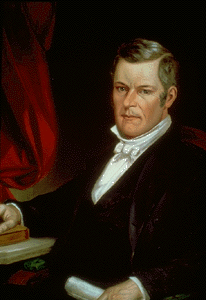Jacob Cox
Artist, Indiana Governors' Portrait Collection

James Brown Ray (1794-1848)
Governor of Indiana
February 12, 1825-December 7, 1831
Artist: Jacob Cox, American, 1810-1892
oil on canvas, 36 1/8 x 29 1/8 (91.7 x 74.0)
Unsigned
THE PORTRAIT of James Brown Ray brings the name of another painter into this discussion. The portrait has no signature, but Dunn is our authority for assigning it to Jacob Cox, dean of the Indianapolis artists during the post-Civil War period, and one of the most revered painters in the state.(1) The style or method of painting supports this attribution. Since the portrait is not dated, the circumstances of its execution are left in question. If James Ray sat for the portrait, it was made early in Cox's career as a painter, for Governor Ray died in 1848. If it was made at the order of Governor Baker in 1869, Cox would have used either a photograph or another painting.
A study of the portrait leads us to the conclusion that it was painted from life and not from a photograph or painting as in the case of previously mentioned works. Also, in comparing it with other portraits by Cox, it seems to be among the artist's earliest known portraits, dating before 1840, (2) and is therefore one of the earliest works in the collection.
If the portrait is so early a production, it was not, in all probability, commissioned by the state. We may surmise that Ray conceded to the artist's wish to make a study of him, and that the painting remained in the artist's studio until Governor Baker acquired it in 1869. Although the execution is far from skillful, the artist has invested the figure with character and vitality - the strongest argument for the conclusion that the picture was painted from life. Ray's expression is not genial - he seems to have adopted here the sullen and cantankerous manner of his later years.(3)
Jacob Cox was born near Philadelphia in 1810, and his youth was spent in Philadelphia and in Washington, Pennsylvania. When he was about twenty years old, he went by boat, with his bride and his brother, from Pittsburgh to Cincinnati. in 1833, they came to Indianapolis, where the brothers established a stove, tinware, and coppersmith business. Jacob had displayed some talent for art in his boyhood days, but he was persuaded to take up a more practical trade and was discouraged from taking instruction in drawing and painting. The tinware establishment was very successful here, but Jacob found his eagerness to paint overshadowing his interest in business, and spare moments given to sketching and reading art books multiplied until painting became the dominant interest of his life. He opened a studio in Indianapolis in 1835 and began his long career as an Indiana painter, which was interrupted by a short stay in Cincinnati in 1842, His reputation grew rapidly, and within a few years he became the leading artist of Indianapolis, receiving many important commissions and attracting to his studio most of the art students of the period. He retained his popularity until his death in 1892. (4)
(1) Dunn, Greater Indianapolis, I, 481.
(2) Peat assigns this portrait to the year 1840 and that of the following, Noah Noble . . . to 1837 based on comparisons with other dated or datable portraits by Cox. In the light of recent conservation of these paintings, this editor believes that no such accurate dating can be assigned to the portraits particularly since both pictures are products of the artist's early career when his style was likely to be inconsistent. Until more conclusive documentary evidence can be found, the general dates of 1835, the date of Cox's earliest portraits, to 1840, have been given to these pictures.
(3) Ray's closely cropped hairstyle as depicted in the portrait before its 1978 conservation treatment did not conform to the account of the governor's appearance described above. There was evidence, however, to indicate that Ray was painted by Cox with long hair hanging straight down the back of his neck. Early photographs of the portrait confirmed this supposition. Damages to the canvas indicate vigorous overcleaning by a previous restorer in the area at the back of Ray's neck. The localized damage indicated either a purposeful change in the portrait to alter the sitter's appearance, or a misunderstanding on the part of the restorer as to the artist's intention. During the 1978 conservation treatment, the overpaint in this area was removed to reveal the dark shadow behind Ray's neck which still reads convincingly as long, straight hair.
(4) For more detailed information on Jacob Cox, see Wilbur D. Peat, Paintings by Jacob Cox - A Retrospective Exhibition of Work by and Early Indianapolis Artist, (ex. cat.) Indianapolis, John Herron Art Museum, November 8-30, 1941.
Source: Peat, Wilbur D. Portraits and Painters of the Governors of Indiana 1800-1978. Revised, edited and with new entries by Diane Gail Lazarus, Indianapolis Museum of Art. Biographies of the governors by Lana Ruegamer, Indiana Historical Society. Indianapolis: Indiana Historical Society and Indianapolis Museum of Art, 1978.
